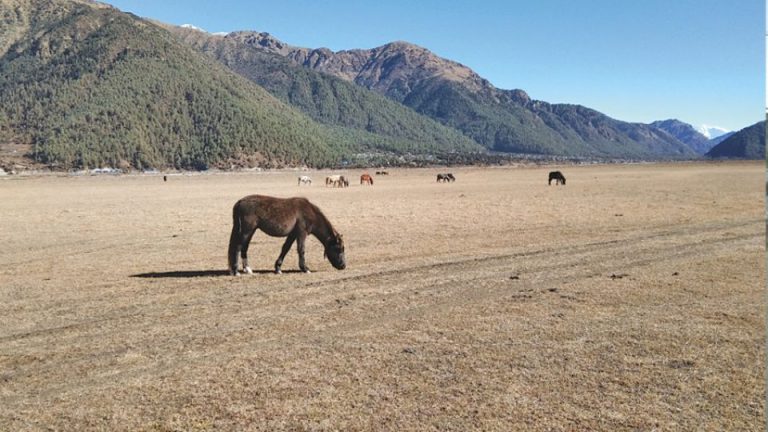Tourism is often hailed as a catalyst for economic growth, bringing direct benefits such as foreign exchange earnings and government revenue. However, at Nepal’s only hunting reserve, Dhorpatan, the impact on local livelihoods remains negligible despite decades of high-spending foreign visitors.
A Hunting Destination for the Elite
Dhorpatan Hunting Reserve, located 126 kilometers west of Baglung district headquarters, spans 1,325 square kilometers and is the only designated hunting area in Nepal. It attracts elite foreign hunters willing to pay millions to legally hunt blue sheep and other game animals. The reserve is divided into six hunting blocks, offering controlled hunting opportunities while generating significant revenue for the government.
Foreign hunters arrive in chartered helicopters and leased jeeps, ensuring seamless travel. However, the influx of wealth has not translated into improved local infrastructure or living standards for the people of Dhorpatan.
A Community Left Behind
While foreign hunters enjoy luxury travel, locals struggle with poor transportation facilities. The roads remain in disrepair, forcing residents, including children and the elderly, to traverse difficult terrains on foot. Many travel long distances with walking sticks, moving between Bobang, Dhorpatan, Buki, and Jaljala due to the absence of reliable transport.
Education Crisis
Dhorpatan is home to around 2,000 students studying in five schools, yet these institutions lack basic facilities. Classrooms have broken furniture, inadequate drinking water, and no midday meal program.
“Most children come to school hungry. We cannot give them lunch,” said Indra Kumari Gharti Magar, a local teacher. “How can they concentrate on their studies?”
In the rainy season, children must cross dense forests and rivers to reach school, leading to frequent absenteeism.
Healthcare Gaps and Emergency Struggles
The region lacks a proper health facility. There is no hospital or health post, and the community heavily depends on an army barracks for medical assistance. On average, army medics treat 20 patients daily, despite limited supplies.
“The medicine is primarily for army personnel, but we cannot turn away local patients,” said an anonymous army officer. “Most common health issues include uterus-related complications and disabilities.”
In critical cases, patients must travel 36 kilometers to Burtibang for treatment. Without proper transport, emergency medical situations often turn fatal. Pregnant women and severely ill patients are particularly vulnerable.
Harsh Living Conditions and Food Insecurity
Over 3,000 households in Dhorpatan rely on temporary shelters. The harsh weather and remote location make daily survival a challenge. Locals depend heavily on potato farming, as other crops are difficult to grow at such high altitudes.
“We could store potatoes for year-round consumption and sell them during winter if we had storage facilities,” said farmer Tek Bahadur Sunar. However, lack of electricity prevents proper storage, leading to food wastage.
Wild boars, which cannot be hunted under current regulations, frequently destroy potato farms, worsening food scarcity. Some desperate farmers resort to slaughtering cows, citing food shortages as the reason.
Infrastructure Neglect and Lack of Basic Amenities
Despite millions being invested in maintaining the Dhorbarah temple, the local government has not prioritized education, healthcare, or drinking water. Many locals remain unaware that these are basic rights their government should guarantee.
“We have repeatedly requested funding for basic projects, but the budget is always insufficient,” said Bhadra Mani Sunar, the ward chairman.
Drinking water is another major issue. Some households have access to local water sources, but many rely on distant rivers like Uttar Ganga, Dhorkhola, and Gaprakhola for water.
Lack of Connectivity Hinders Progress
Dhorpatan remains cut off from digital connectivity. A 2G service was introduced in Nisheldhor this year, but operating 4G requires access to the national power grid.
“Without electricity, launching 4G is impossible,” said Santosh Baral, chief of Nepal Telecom’s Baglung office.
The absence of internet also affects tourism promotion. Visitors cannot share photos and experiences instantly, limiting Dhorpatan’s visibility on digital platforms.
Tourism Revenue Fails to Uplift the Locals
Tourism brings millions to Dhorpatan, but the local population sees little benefit. While foreign hunters pay hefty fees to shoot game animals, basic needs like roads, healthcare, education, and electricity remain unmet for residents.
The Dhorpatan-Saljhadi road has been under construction for 16 years, leaving the area poorly connected. Without urgent intervention, the region will continue to be a paradox—thriving in tourism revenue but failing its people.
Dhorpatan’s unique wildlife and natural beauty make it a valuable tourism asset. However, without government intervention in infrastructure, healthcare, and education, the locals will remain in poverty. Authorities must ensure that tourism revenue benefits the residents as much as the government.


